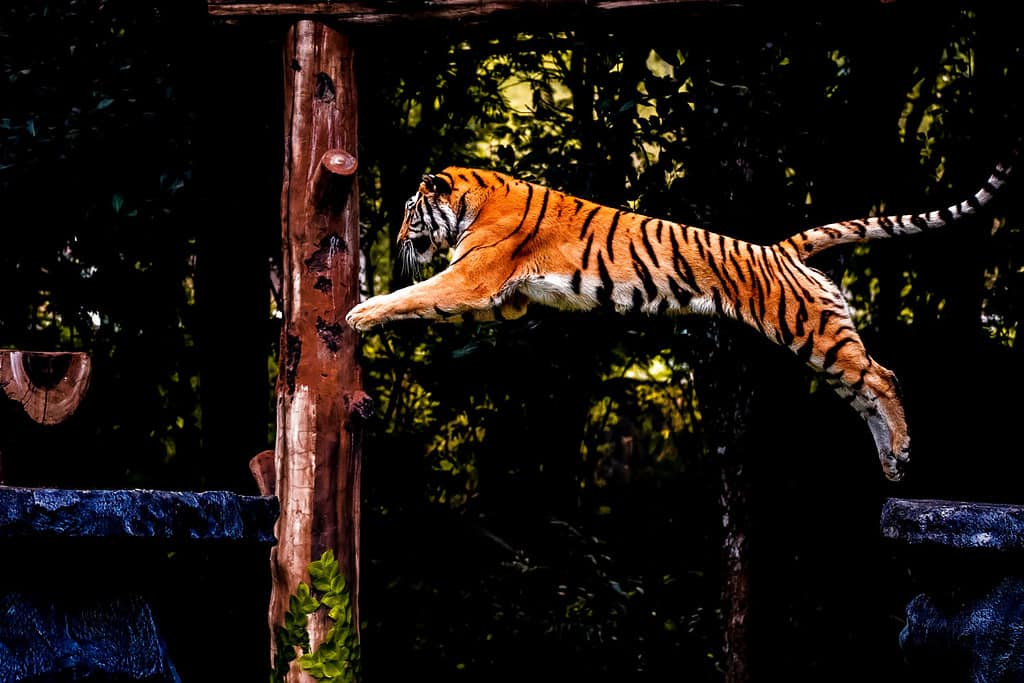Continue reading for our analysis...

Tigers are finely tuned killing machines – apex predators and highly skilled hunters. There are nine subspecies of tiger and each has a slightly different coloration but they are all large and magnificent creatures.
Despite their huge size, they are surprisingly agile and this is captured perfectly in this slow-motion short video. We see an adult tiger eagerly anticipating a meal and springing many feet into the air when the meat is hurled out of the truck!
The Hunting Machine That Is the Tiger

Tigers have size, speed, 4-inch-long sharp claws, and sharp teeth which enable them to catch their prey in the wild.
©Borkin Vadim/Shutterstock.com
Tigers have size, speed, 4-inch-long sharp claws, and sharp teeth which enable them to catch their prey in the wild. A grown tiger can weigh up to 675 pounds and grow up to 10.5 feet in length. They are carnivores and have to capture large quantities of meat to survive.
In the wild, a tiger would hunt deer, antelope buffalo, and wild boar but they will also devour monkeys and have even been known to eat a crocodile. They usually eat once a week but have huge portions – up to 75 pounds of meat in one enormous meal! If they don’t manage to finish off the meal in one sitting, they will hide it under some leaves and come back for it later.
In this short clip, we see a combination of attributes that tigers use to hunt successfully. Initially, we see total focus and commitment as the tiger paces around whilst staring at the meat and prepares the hind legs, in particular, for an explosive burst of energy.
Then we see the power of the hind leg muscles as the body is propelled into the air. Finally, we have to marvel at the accuracy as the tiger twists in midair to grab at the meat with both forelimbs and secures it before it reaches the ground.
Tiger Lifespan
The average lifespan of a tiger in the wild is around 8 to 10 years, although they can live up to 15 years in some cases. In captivity, tigers have been known to live up to 20 years or more, due to improved living conditions and veterinary care.
However, the lifespan of a tiger is heavily influenced by a variety of factors, including genetic factors, diet, habitat, and exposure to disease and predation.
Another factor that can impact the lifespan of a tiger is its diet. Tigers are carnivores and require a large amount of food to support their large bodies. In the wild, they hunt and feed on a variety of prey, including deer, wild pigs, and other mammals. However, if food is scarce, tigers may struggle to find enough to eat, which can impact their health and lifespan.
In captivity, tigers are generally protected from many of the risks they face in the wild, such as predation and competition for food.
However, they may still face several health challenges, such as obesity, dental problems, and stress-related disorders. To ensure the health and longevity of captive tigers, it is important to provide them with a balanced diet, proper veterinary care, and a safe and stimulating environment.
Overall, the lifespan of a tiger is influenced by a complex interplay of genetic, environmental, and behavioral factors. Despite the many challenges they face, tigers are one of the most resilient and adaptable animals in the world and will continue to play an important role in their ecosystem for many years to come.
Tiger Reproduction
Female tigers are sexually mature by age three, but males not until 5-6 years of age. Tigers may have several mates over a lifetime. When the female is in heat (usually 2-6 days every 3-9 weeks until she becomes pregnant), she will scent-mark her range with urine and may frequently vocalize to attract a male. Then they have a solitary meeting in which they circle each other and vocalize. Copulation will continue repeatedly over the fertile period, possibly as much as 150 times over several days.
The act of mating induces the female to release an egg for fertilization. The resulting gestation period lasts about three months ending in the birth of two to four cubs about every two years. Tiger babies stay with their mothers until they are about two years old.
Tiger Habitat Loss and Competition
The tigers in the footage are clearly on a reserve and only have each other to compete with. We are sure that the other tiger in this video also got its fair share of meat a bit later! Sadly, in the wild, this is not the case.
Due to deforestation, the tiger’s habitat is under threat, and there is too much competition for food, so numbers are decreasing. Also, they are poached because tiger skin, fur, and teeth are highly prized and valuable. It would be a tragedy if this magnificent animal were to become extinct but there is some good news.
According to World Wildlife Fund data, wild tiger numbers are stabilizing and are slightly increasing in areas such as Russia, China, Bhutan, and Nepal. There is still a lot to do, though, because tigers in Southeast Asia are currently in crisis.
Is This Normal Behavior for Tigers?

Tigers are well known for stalking their prey for hours before jumping out and leaping on them.
©Agus Sudharnoko/Shutterstock.com
Tigers are apex predators and do not have any parallel in the jungle. The only other apex predator that compares with Tigers in ferocity are alligators in the water.
There have been quite many legendary fights between these two creatures, however, neither could prove hierarchy over the other in their natural habitat.
Tigers are well known for hiding in plain sight and stalking their prey for hours before jumping out, leaping on it, and catching it unawares.
Tigers are powerful animals they usually kill their prey by breaking their neck between their powerful jaw. It is also normal for Tigers to jump 18 to 20 feet in the air while hunting their prey.
Thank you for reading! Have some feedback for us? Contact the AZ Animals editorial team.






